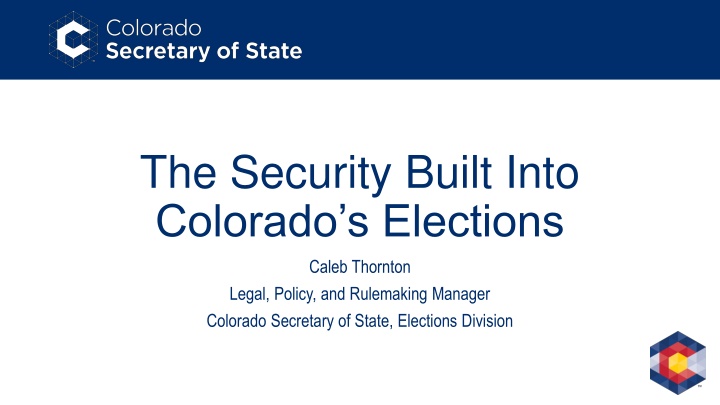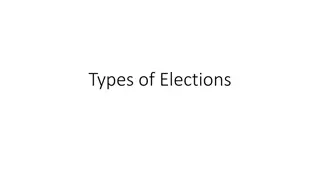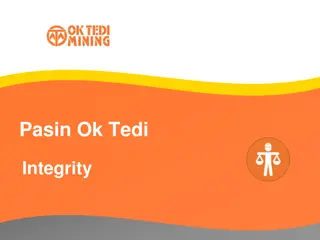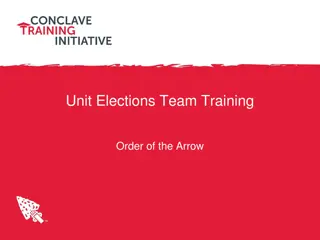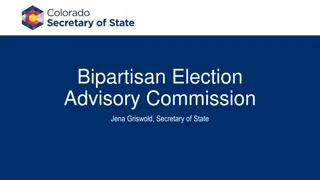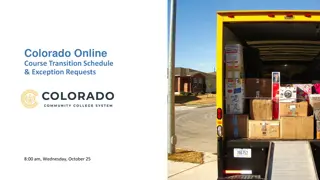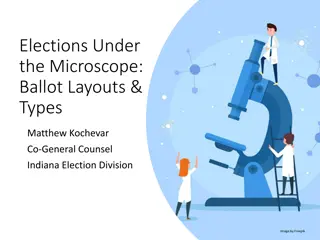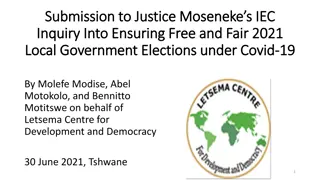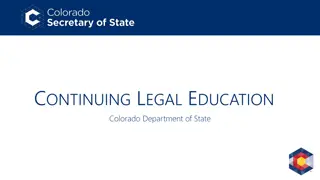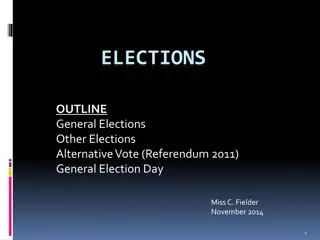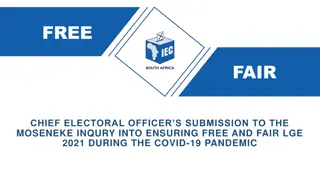Ensuring Security and Integrity in Colorado's Elections
Explore the comprehensive security measures and legal framework implemented in Colorado's elections, guided by state laws and federal regulations. Learn about the historical context, current standards, and future considerations for maintaining the purity and fairness of electoral processes in Colorado, aligned with constitutional mandates and key legislative acts.
Download Presentation

Please find below an Image/Link to download the presentation.
The content on the website is provided AS IS for your information and personal use only. It may not be sold, licensed, or shared on other websites without obtaining consent from the author.If you encounter any issues during the download, it is possible that the publisher has removed the file from their server.
You are allowed to download the files provided on this website for personal or commercial use, subject to the condition that they are used lawfully. All files are the property of their respective owners.
The content on the website is provided AS IS for your information and personal use only. It may not be sold, licensed, or shared on other websites without obtaining consent from the author.
E N D
Presentation Transcript
The Security Built Into Colorado s Elections Caleb Thornton Legal, Policy, and Rulemaking Manager Colorado Secretary of State, Elections Division
CDOS Continuing Legal Education Variety of topics - Title Board, Cybersecurity, Notary, and more! Once per month through October Visit online to sign-up at: https://www.coloradosos.gov/pubs/info_center/CLEseminars.html Next session July 11, What is Title Board?
Course Objectives Why does it matter and how d we get here? Three areas of concern: List maintenance System testing Ballot integrity Where do we go from here?
Why Does it Matter? Survey conducted by CU Boulder and YouGov Elections across the country will be conducted fairly and accurately 75% of Democrats 46% of Independents 41% of Republicans Elections in Colorado will be conducted fairly and accurately 88% of Democrats 63% of Independents 54% of Republicans
Colorado Constitution Article II, Section 5: Freedom of elections. All elections shall be free and open; and no power, civil or military, shall at any time interfere to prevent the free exercise of the right of suffrage. Article VII, Section 11: Purity of elections. The general assembly shall pass laws to secure the purity of elections, and guard against abuses of the elective franchise.
HB 1303 Created many standards that we follow today Mail ballots Standardized list maintenance Vote centers Central counting Same-day voter registration
Federal Law National Voter Registration Act (NVRA) of 1993 Standardize list maintenance procedures Motor voter Help America Vote Act (HAVA) Replacement of old voting systems (punch cards) Creation of Election Assistance Commission (EAC) Creation of voting system standards
List Maintenance What is it? The process state and county election officials use to maintain accurate and up-to-date voter rolls. Basic Terminology Active vs. Inactive vs. Cancelled
List Maintenance, Federal Law NVRA Created a process by which states could cancel voters off voter roll Requires states to, conduct a general program that makes a reasonable effort to remove the names of ineligible voters from the official lists of eligible voters. Use postal service national change of address information Mailing + 2 general elections = cancelled
List Maintenance, Colorado Use of Federal Law Colorado law built off NVRA Mailing + 2 general elections = cancelled Inactive status Mail ballot returned as undeliverable (unique to mail ballot for all states) Postal service information Information from DMV Automatic voter registration Automatic voter updates
List Maintenance, Other Sources Cancellation due to death or felony resulting in incarceration CDPHE (monthly twice month before election) CDOC (daily) Electronic Registration Information Center (ERIC) Founding member Use of social security death data Identification of double voters https://www.miamiherald.com/news/politics-government/state-politics/article288851685.html
List Maintenance Common Questions/Misperceptions Q: Why does Colorado have more registered voters than people? A: We don t. Comparison of incomparable data. Misunderstanding of active vs. inactive Q: Why did [insert person here] get a ballot to my house even though they moved? A: Data takes time to catch up. Return to sender to begin process of inactivation.
System Security and Testing, Overview What is it? Procedures in place to make sure machines used to cast and tabulate votes are working properly Basic Terminology Electromechanical voting system a system in which an elector votes using a device for marking a ballot card using ink or another visible substance and the votes are counted with electronic vote-tabulating equipment. Includes tabulators, workstations, ballot marking devices, etc. Trusted build means the write-once installation disk or disks for software and firmware for which the Secretary of State has established the chain-of-custody to the building of the disks . . . The trusted build is the origin of the chain-of-custody for any software and firmware component of the voting system. Logic and accuracy test Pre-election test conducted to verify system is counting accurately Risk-limiting audit Post-election audit that gives a statistical level of confidence that the outcome of an election is correct.
System Security and Testing Timeline Testing and Certification Logic and Accuracy Test Risk-Limiting Audit Trusted Build
System Security and Testing, Step 1 Testing and Certification Colorado law requires systems to meet specific standards for certification Certification is a five-phase process that involves SOS staff, voting system vendor, and a voting system test lab accredited by the Election Assistance Commission. Within 30 days of certification, all documentation not determined to be proprietary or security related is posted online. Find all of this for every certified system online here: https://www.coloradosos.gov/pubs/elections/VotingSystems/VSHomePage1.html
System Security and Testing, Step 2 Trusted Build Fancy name for secure installation of verified software onto clean system components Conducted by background checked staff from Department of State with county and vendor personnel present. Conducted under camera. Establishes initial chain of custody for every system component
System Security and Testing, Step 3 Logic and Accuracy Test Test conducted before every election Open to members of the public Ballots with known results along with hand marked ballots run through tabulators Tabulated results compared to hand tally results by bi-partisan team appointed by local parties
System Security and Testing, Step 4 Risk-Limiting Audit SOS sets a risk limit before every election. means the largest statistical probability that an incorrect reported tabulation outcome is not detected and corrected in a risk-limiting audit. Following tabulation, counties upload the tabulated results for each anonymous ballot Ten sided dice rolled 20 times to determine random seed Random seed determines ballots to be audited Bi-partisan election judges review ballot selected If tabulation for those ballots matches hand count (to satisfy risk limit) audit is complete If not, audit continues into 2nd, 3rdrounds as necessary
System Security and Testing, Step 4 (cont.) Risk-Limiting Audit CO first in the country to adopt this on statewide level Possible because of paper ballot records Never failed a risk-limiting audit and no discrepancy has ever been due to tabulation machine error.
System Security and Testing Common Questions/Misperceptions Q: Isn t every system hackable and thus inherently not secure? A: CO mitigates this threat through use of system testing, paper ballots, post-election audits, and other physical security (seals, cameras, etc.). Q: Why can t we just hand count everything? A: Hand counting is less accurate, more time consuming, and not realistic, particularly for Colorado s lengthy ballots (several dozen races to count this upcoming general). Machines don t get tired - election judges do.
Ballot Integrity, Overview What is it? Procedures in place to ensure that ballots were cast by registered voters, and that only those ballots cast by registered voters were counted. Basic Terminology: Signature verification The process of using a comparison of signature to confirm identity. Canvass Final act in an election. Certifies final abstract of votes. Abstract of Votes Cast Final official tally of votes in each race.
Ballot Integrity, Identification Signature Verification: Primary method of identity verification in Colorado Election judges receive training before every election must follow Signature Verification Guide Process Single judge verifies signature. If judge believes it does not match, signature goes to second tier of two election judges If all 3 agree signature does not match, signature placed into cure status Great NYT write-up of the process: https://www.nytimes.com/interactive/2020/10/07/upshot/mail-voting-ballots-signature-matching.html
Ballot Integrity, Maintaining Custody Chain-of-Custody Transportation of ballots from locked drop boxes to central count completed in secure containers with bi-partisan judges. Ballot removal and tabulation conducted in secure location with limited access. All ballot processing conducted by bi-partisan judges in view of election watchers. After tabulation, ballots stored in secure containers with tamper-evident seals for 25 months.
Ballot Integrity, Canvassing Canvass Last official act of the election Conducted by Republican-Democrat-clerk Duties: Ballots counted is < ballots cast Ballots cast < registered voters Certify the abstract of votes cast Confirms that additional ballots weren t stuffed into the system
Ballot Integrity Common Questions/Misperceptions Q: Are drop boxes safe? A: Yes. Drop boxes are secure metal containers, bolted to the ground, under video surveillance. Dropping ballots in a drop box removes the middleman USPS and ensures timely delivery of your ballot directly to election officials.
Where do we go from here? Spread the good news! Colorado s elections are safe, secure, and can be trusted. Don t take my word for it Talk to your county clerk Serve as an election judge or watcher Take a tour Be skeptical of what you hear from outside sources Foreign governments and domestic actors use social media to spread disinformation Webpage on disinformation and what you can do about it here
Questions? Call or email me with questions. If I don t know the answer, I ll try to find someone who does. 303-894-2200 ext. 6386 Caleb.Thornton@coloradosos.gov
CLE Credit Logon to CLE tracker enter Course ID: 838829
CDOS Continuing Legal Education Reminder Variety of topics - Title Board, Cybersecurity, Notary, and more! Once per month through October Visit online to sign-up at: https://www.coloradosos.gov/pubs/info_center/CLEseminars.html Next session July 11, What is Title Board?
